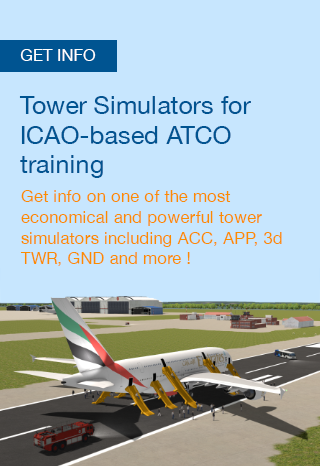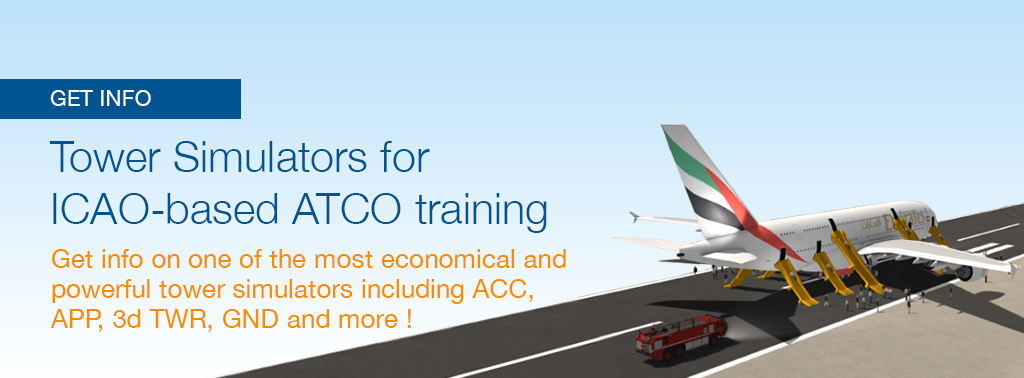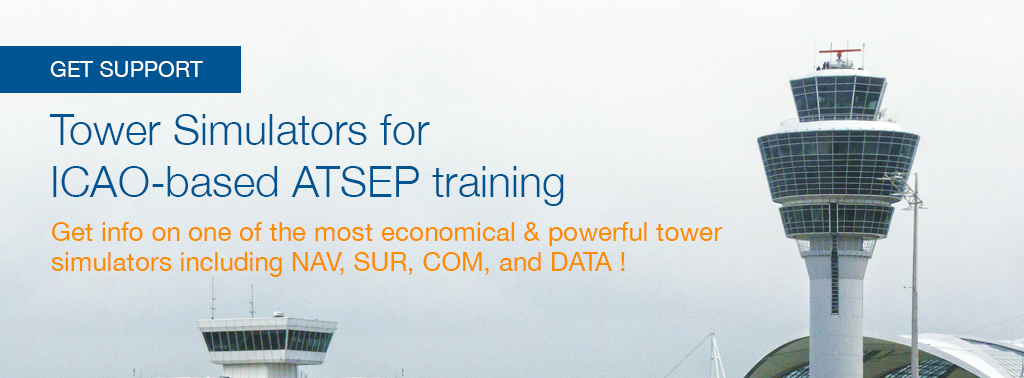Tower Simulators should comprise the A-SMGCS (Advanced Surface Movement Guidance & Control System) to provide important simulations for routing, guidance, and surveillance for controlling aircraft. The ATCO will learn how to maintain the stated surface movement rate regardless of the weather conditions.
A-SMGCS is done within the aerodrome visibility operational level (AVOL) while maintaining the level of safety required according to ICAO Doc 9830: Advanced Surface Movement Guidance and Control Systems (A-SMGCS) Manual.
The ICAO Manual describes A-SMGCS as consisting of four basic functions:
The A-SMGCS simulator replicates the modular system environment of an actual A-SMGCS system. It provides different functionalities that support the safe, orderly, and expeditious movement of aircraft and vehicles on aerodromes under all probable scenarios.
It does this by considering the aerodrome’s layout and its traffic density and complexity and capacity demands under various visibility conditions independent of the line-of-sight connection between the controller and aircraft.
Delivering Improved Situational Awareness
The aim of the A-SMGCS simulator at its lower levels of implementation is to deliver improved situational awareness to controller trainees in addition to complementary procedures. At its higher levels of implementation, A-SMGCS delivers:
- Safety nets
- Conflict detection and resolution
- Information for pilots and controllers regarding planning and guidance information
- Detection and position indication of potential intruders
A-SMGSC acts as a key enabler for the Integrated Tower Working Position (ITWP). The ITWP combines surveillance, controller tools, and safety nets for aerodrome controllers.
The Four Levels of A-SMGCS under ICAO
ICAO defined four levels of A-SMGCS implementation in 2004 based on a complex and traffic density approach.
- A-SMGCS Level 1 (improved Surveillance) provides improved surveillance and procedures by covering the maneuvering area for the movement area for aircraft and maneuvering areas for ground vehicles. Its procedures cover identification and issuing ATC instructions and clearances. In an important step forward from a traditional Surface Movement Radar (SMR) image, controllers are given identity information and traffic position.
- A-SMGCS Level 2 (Surveillance + Safety Nets) adds safety nets to surveillance to protect runways and restricted areas with its associated procedures. During simulations, appropriate alerts are generated to alert controllers to conflicts between all vehicles situated on runways and aircraft incursion into restricted areas.
- A-SMGCS Level 3 (Conflict Detection) simulates the detection of all conflicts within the movement area. Additionally, there is improved access to guidance and planning for controllers to use.
- A-SMGCS Level 4 (Conflict Resolution, Automatic Planning & Guidance) simulates resolutions for all conflicts as well as automatic planning and guidance for both controllers and pilots.
The Four A-SMGCS Services under EUROCONTROL
Recently, EUROCONTROL removed references to “Levels” in its guidance material for A-SMGCS implementations. Instead, it has opted for a more functional definition of the services provided by A-SMGCS. To avoid confusion with the ICAO Manual and to prevent assumptions that the functions must be implemented in numerical order, the functions/services are referred to by name. This is not a contradiction between ICAO and EUROCONTROL’s definition of A-SMGCS services because they continue to provide the same functionalities, just from a different perspective.
EUROCONTROL defines the four A-SMGCS services as:
- Surveillance Service that provides airport traffic situational awareness via a Human Machine Interface (HMI) for identification, position, and tracking of aircraft and vehicles within a predefined coverage volume.
- Airport Safety Support Service that contributes to airside operation as a safety improvement. It prevents hazards/incidents that result from operational errors or deviations made by the controller, flight crew, or vehicle driver. This service relies on the Surveillance service being operational and is based on these three functions:
- Runway Monitoring and Conflict Alerting (RMCA), which is a short-term conflict alerting tool that monitors movements near or on the runway and detects conflicts between an aircraft and another vehicle. It relies on data and predefined rules and parameters from the Surveillance service.
- Conflicting ATC Clearances (CATC) provides an alert if the controller inputs an electronic clearance via the HMI that contradicts the set of locally agreed rules of what is not permitted from an operational and safety point of view when compared to previously input electronic clearance.
- Conformance Monitoring Alerts for Controllers (CMAC) provides appropriate alerts to controllers when the A-SMGCS detects anomalies to procedures or clearances for runway traffic, taxiways, and the apron area.
Routing Service generates a route for each mobile that is based on known aerodrome parameters and constraints or after an interaction with the Controller. This generates accurate taxi times from the route that can be used by the A-CDM platform. Routing allows the Controller to create or modify a route and input several performance-enhancing maneuvers that are widely used at aerodromes into the system, such as:
- Push/pull maneuvers
- Deep or long pushback
- Alternative Parallel Taxi Routing (APTR)
It is the main enabler for the Guidance service and several Airport Safety Support service elements, including the Route Deviation Alert.
Guidance Service that works with controller inputs and the Surveillance and Routing services to provide the following functions:
- Automated switching of Taxiway Centreline Lights (TCL)
- Automated switching of Stop Bars
- Automated activation of Advanced-Visual Docking Guidance Systems (A-VDGS)
SkyRadar's Tower Simulator including A-SMGCS
Learn more about our A-SMGCS functionalities in the article:
Technical Features of a Tower Simulator including an Advanced Surface Movement Guidance & Control System (A-SMGCS)
Stay tuned by receiving weekly updates on training features, research, and other news in the fields of ATCO and ATSEP training!
References
- Advanced Surface Movement Guidance and Control System (A-SMGCS) (retrieved October 2020), by Skybrary
- ICAO Doc 9830: Advanced Surface Movement Guidance and Control Systems (A-SMGCS) Manual)






